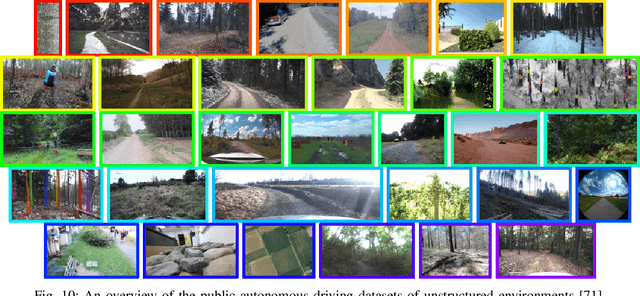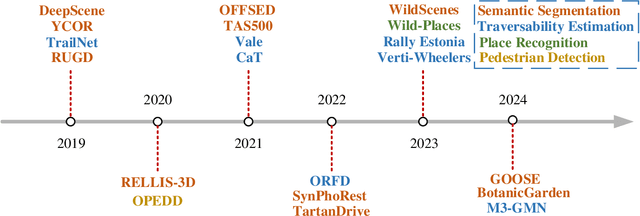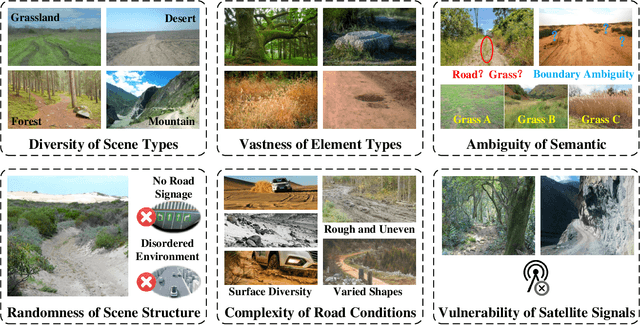Tong Sun
Towards Visual Text Grounding of Multimodal Large Language Model
Apr 07, 2025Abstract:Despite the existing evolution of Multimodal Large Language Models (MLLMs), a non-neglectable limitation remains in their struggle with visual text grounding, especially in text-rich images of documents. Document images, such as scanned forms and infographics, highlight critical challenges due to their complex layouts and textual content. However, current benchmarks do not fully address these challenges, as they mostly focus on visual grounding on natural images, rather than text-rich document images. Thus, to bridge this gap, we introduce TRIG, a novel task with a newly designed instruction dataset for benchmarking and improving the Text-Rich Image Grounding capabilities of MLLMs in document question-answering. Specifically, we propose an OCR-LLM-human interaction pipeline to create 800 manually annotated question-answer pairs as a benchmark and a large-scale training set of 90$ synthetic data based on four diverse datasets. A comprehensive evaluation of various MLLMs on our proposed benchmark exposes substantial limitations in their grounding capability on text-rich images. In addition, we propose two simple and effective TRIG methods based on general instruction tuning and plug-and-play efficient embedding, respectively. By finetuning MLLMs on our synthetic dataset, they promisingly improve spatial reasoning and grounding capabilities.
MDocAgent: A Multi-Modal Multi-Agent Framework for Document Understanding
Mar 18, 2025Abstract:Document Question Answering (DocQA) is a very common task. Existing methods using Large Language Models (LLMs) or Large Vision Language Models (LVLMs) and Retrieval Augmented Generation (RAG) often prioritize information from a single modal, failing to effectively integrate textual and visual cues. These approaches struggle with complex multi-modal reasoning, limiting their performance on real-world documents. We present MDocAgent (A Multi-Modal Multi-Agent Framework for Document Understanding), a novel RAG and multi-agent framework that leverages both text and image. Our system employs five specialized agents: a general agent, a critical agent, a text agent, an image agent and a summarizing agent. These agents engage in multi-modal context retrieval, combining their individual insights to achieve a more comprehensive understanding of the document's content. This collaborative approach enables the system to synthesize information from both textual and visual components, leading to improved accuracy in question answering. Preliminary experiments on five benchmarks like MMLongBench, LongDocURL demonstrate the effectiveness of our MDocAgent, achieve an average improvement of 12.1% compared to current state-of-the-art method. This work contributes to the development of more robust and comprehensive DocQA systems capable of handling the complexities of real-world documents containing rich textual and visual information. Our data and code are available at https://github.com/aiming-lab/MDocAgent.
Persona-SQ: A Personalized Suggested Question Generation Framework For Real-world Documents
Dec 17, 2024



Abstract:Suggested questions (SQs) provide an effective initial interface for users to engage with their documents in AI-powered reading applications. In practical reading sessions, users have diverse backgrounds and reading goals, yet current SQ features typically ignore such user information, resulting in homogeneous or ineffective questions. We introduce a pipeline that generates personalized SQs by incorporating reader profiles (professions and reading goals) and demonstrate its utility in two ways: 1) as an improved SQ generation pipeline that produces higher quality and more diverse questions compared to current baselines, and 2) as a data generator to fine-tune extremely small models that perform competitively with much larger models on SQ generation. Our approach can not only serve as a drop-in replacement in current SQ systems to immediately improve their performance but also help develop on-device SQ models that can run locally to deliver fast and private SQ experience.
Numerical Pruning for Efficient Autoregressive Models
Dec 17, 2024



Abstract:Transformers have emerged as the leading architecture in deep learning, proving to be versatile and highly effective across diverse domains beyond language and image processing. However, their impressive performance often incurs high computational costs due to their substantial model size. This paper focuses on compressing decoder-only transformer-based autoregressive models through structural weight pruning to improve the model efficiency while preserving performance for both language and image generation tasks. Specifically, we propose a training-free pruning method that calculates a numerical score with Newton's method for the Attention and MLP modules, respectively. Besides, we further propose another compensation algorithm to recover the pruned model for better performance. To verify the effectiveness of our method, we provide both theoretical support and extensive experiments. Our experiments show that our method achieves state-of-the-art performance with reduced memory usage and faster generation speeds on GPUs.
SUGAR: Subject-Driven Video Customization in a Zero-Shot Manner
Dec 13, 2024Abstract:We present SUGAR, a zero-shot method for subject-driven video customization. Given an input image, SUGAR is capable of generating videos for the subject contained in the image and aligning the generation with arbitrary visual attributes such as style and motion specified by user-input text. Unlike previous methods, which require test-time fine-tuning or fail to generate text-aligned videos, SUGAR achieves superior results without the need for extra cost at test-time. To enable zero-shot capability, we introduce a scalable pipeline to construct synthetic dataset which is specifically designed for subject-driven customization, leading to 2.5 millions of image-video-text triplets. Additionally, we propose several methods to enhance our model, including special attention designs, improved training strategies, and a refined sampling algorithm. Extensive experiments are conducted. Compared to previous methods, SUGAR achieves state-of-the-art results in identity preservation, video dynamics, and video-text alignment for subject-driven video customization, demonstrating the effectiveness of our proposed method.
LoRA-Contextualizing Adaptation of Large Multimodal Models for Long Document Understanding
Nov 02, 2024Abstract:Large multimodal models (LMMs) have recently shown great progress in text-rich image understanding, yet they still struggle with complex, multi-page, visually-rich documents. Traditional methods using document parsers for retrieval-augmented generation suffer from performance and efficiency limitations, while directly presenting all pages to LMMs leads to inefficiencies, especially with lengthy documents. In this work, we present a novel framework named LoRA-Contextualizing Adaptation of Large multimodal models (LoCAL), which broadens the capabilities of any LMM to support long-document understanding. We demonstrate that LMMs can effectively serve as multimodal retrievers, fetching relevant pages to answer user questions based on these pages. LoCAL is implemented with two specific LMM adapters: one for evidence page retrieval and another for question answering. Empirical results show state-of-the-art performance on public benchmarks, demonstrating the effectiveness of LoCAL.
Autonomous Driving in Unstructured Environments: How Far Have We Come?
Oct 10, 2024



Abstract:Research on autonomous driving in unstructured outdoor environments is less advanced than in structured urban settings due to challenges like environmental diversities and scene complexity. These environments-such as rural areas and rugged terrains-pose unique obstacles that are not common in structured urban areas. Despite these difficulties, autonomous driving in unstructured outdoor environments is crucial for applications in agriculture, mining, and military operations. Our survey reviews over 250 papers for autonomous driving in unstructured outdoor environments, covering offline mapping, pose estimation, environmental perception, path planning, end-to-end autonomous driving, datasets, and relevant challenges. We also discuss emerging trends and future research directions. This review aims to consolidate knowledge and encourage further research for autonomous driving in unstructured environments. To support ongoing work, we maintain an active repository with up-to-date literature and open-source projects at: https://github.com/chaytonmin/Survey-Autonomous-Driving-in-Unstructured-Environments.
LLaVA-Read: Enhancing Reading Ability of Multimodal Language Models
Jul 27, 2024



Abstract:Large multimodal language models have demonstrated impressive capabilities in understanding and manipulating images. However, many of these models struggle with comprehending intensive textual contents embedded within the images, primarily due to the limited text recognition and layout understanding ability. To understand the sources of these limitations, we perform an exploratory analysis showing the drawbacks of classical visual encoders on visual text understanding. Hence, we present LLaVA-Read, a multimodal large language model that utilizes dual visual encoders along with a visual text encoder. Our model surpasses existing state-of-the-art models in various text-rich image understanding tasks, showcasing enhanced comprehension of textual content within images. Together, our research suggests visual text understanding remains an open challenge and an efficient visual text encoder is crucial for future successful multimodal systems.
ARTIST: Improving the Generation of Text-rich Images by Disentanglement
Jun 17, 2024



Abstract:Diffusion models have demonstrated exceptional capabilities in generating a broad spectrum of visual content, yet their proficiency in rendering text is still limited: they often generate inaccurate characters or words that fail to blend well with the underlying image. To address these shortcomings, we introduce a new framework named ARTIST. This framework incorporates a dedicated textual diffusion model to specifically focus on the learning of text structures. Initially, we pretrain this textual model to capture the intricacies of text representation. Subsequently, we finetune a visual diffusion model, enabling it to assimilate textual structure information from the pretrained textual model. This disentangled architecture design and the training strategy significantly enhance the text rendering ability of the diffusion models for text-rich image generation. Additionally, we leverage the capabilities of pretrained large language models to better interpret user intentions, contributing to improved generation quality. Empirical results on the MARIO-Eval benchmark underscore the effectiveness of the proposed method, showing an improvement of up to 15\% in various metrics.
Toffee: Efficient Million-Scale Dataset Construction for Subject-Driven Text-to-Image Generation
Jun 13, 2024



Abstract:In subject-driven text-to-image generation, recent works have achieved superior performance by training the model on synthetic datasets containing numerous image pairs. Trained on these datasets, generative models can produce text-aligned images for specific subject from arbitrary testing image in a zero-shot manner. They even outperform methods which require additional fine-tuning on testing images. However, the cost of creating such datasets is prohibitive for most researchers. To generate a single training pair, current methods fine-tune a pre-trained text-to-image model on the subject image to capture fine-grained details, then use the fine-tuned model to create images for the same subject based on creative text prompts. Consequently, constructing a large-scale dataset with millions of subjects can require hundreds of thousands of GPU hours. To tackle this problem, we propose Toffee, an efficient method to construct datasets for subject-driven editing and generation. Specifically, our dataset construction does not need any subject-level fine-tuning. After pre-training two generative models, we are able to generate infinite number of high-quality samples. We construct the first large-scale dataset for subject-driven image editing and generation, which contains 5 million image pairs, text prompts, and masks. Our dataset is 5 times the size of previous largest dataset, yet our cost is tens of thousands of GPU hours lower. To test the proposed dataset, we also propose a model which is capable of both subject-driven image editing and generation. By simply training the model on our proposed dataset, it obtains competitive results, illustrating the effectiveness of the proposed dataset construction framework.
 Add to Chrome
Add to Chrome Add to Firefox
Add to Firefox Add to Edge
Add to Edge